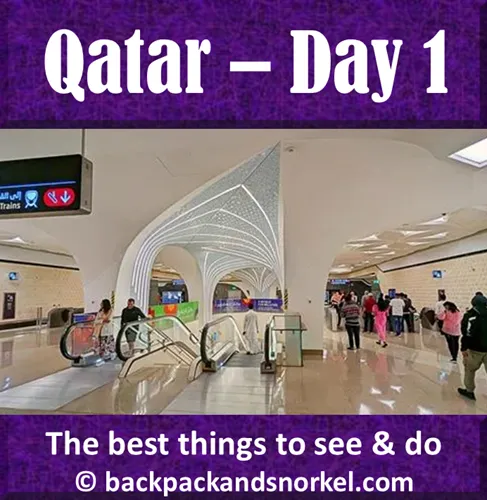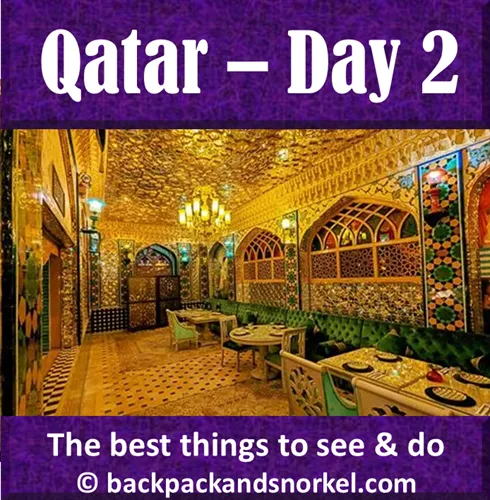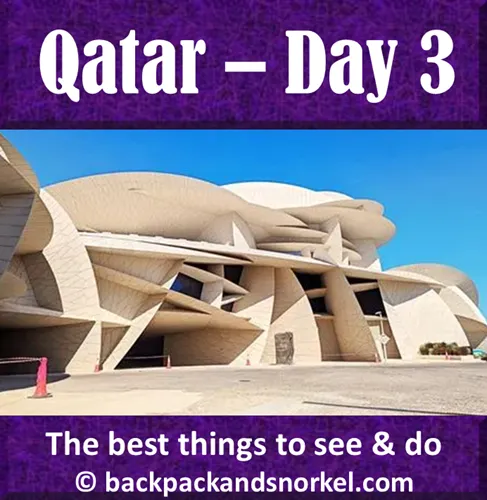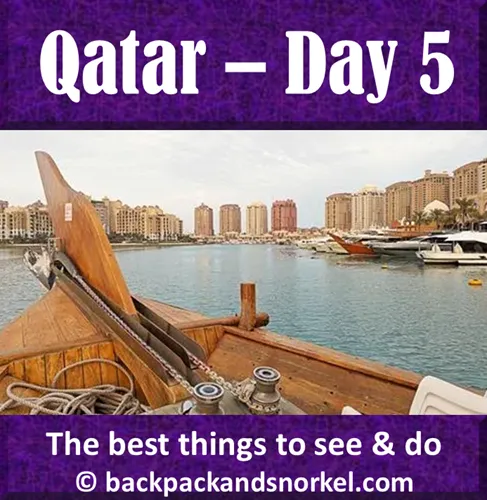Backpack and Snorkel Travel Guide for Qatar - Qatar Purple Travel Guide
With a mixture of traditional and ultra-modern living, stunning desert landscapes, and a comparably liberal society, Qatar is one of the fastest growing tourist destinations in the world. We provide detailed information and the best things to see and we show lots of photos so you know what you can expect.
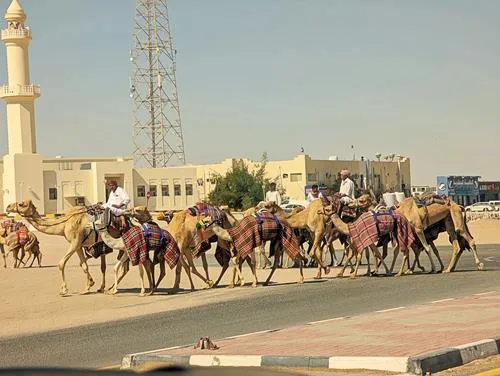

Why you should visit Qatar
Due to the third-largest gas reserves in the world, Qatar has become an Arabian success story.
Qatar has some of the best museums in the Middle East, fantastic desert landscapes, and even beaches. The country has retained some of its traditional living and added lots of ultra-modern and highly sustainable buildings. Its investment into tourism, tied with it comparably liberal society and jobs attracts guest workers and tourists alike, and made Qatar one of the fastest growing tourist destinations in the world.
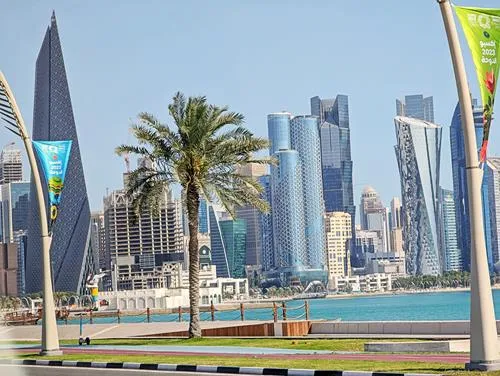
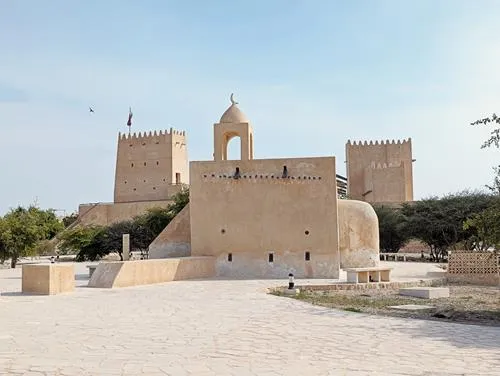
In this Qatar Purple Travel Guide, we provide an 8-day itinerary for Qatar, and tell you what you need to know to visit Qatar.
To help you find out what best fits you, we have added lots of photos and links to google maps locations and additional reviews.
Join us to explore the best things to see and do in Qatar.
General Information about Qatar
Qatar is located on the Qatar Peninsula that branches off the east coast of Saudi Arabia. Its only land border is to Saudi Arabia; the Persian Gulf surrounds the rest of the country.
With its population of 2.6 mio people, a bit over 300,000 being Qatari citizens, and the rest being expats, Qatar has the fourth-highest GDP per capita in the world, the highest government healthcare spending in the Middle East, and the third-highest Human Development Index (HDI) in the Arab world.
Doha is the capital city and home to 80% of Qatar’s population.
Qatar is a hereditary, and almost absolute monarchy, ruled by the House of Thani.
The House of Thani has transformed the country into a comparably open Islamic society. It is not as liberal as Dubai, but much more open that Saudi Arabia.
Non-Islamic religions are tolerated, and there are (sparse) opportunities for non-Muslims to buy alcohol and pork.
All Qatari citizens must attend government-provided education from kindergarten through high school resulting in Qatar having the highest literacy rate in the Arab-speaking world.
The country is also the world's biggest buyer of art by value and home to some excellent museums, especially the Museum of Islamic Art.
Tourism is strongly growing in Qatar and Doha is one of the fastest-growing hotel and hospitality markets in the world.
Do I need a Tourist Visa for Qatar?
Visa requirements can change at any time. We encourage you to check if you need a visa here or here.
At the time of writing, nationals from 101 countries can enter Qatar visa-free, and all others can apply for an e-visa using the Hayya platform online.
Can I drink Tap Water in Qatar?
Qatar authorities claim that tap water in Qatar is safe to drink. However, only about one-third of the people in Qatar drink tap water, because they don’t trust the cleanliness of water storage tanks. Therefore, most travelers consume only bottled water.
Our hotel in Doha also advised us to only drink the bottled water they provide.
Electricity in Qatar
Qatar use a voltage of 230 V and a frequency of 50 Hz (in the US, it is 120 V and 60 Hz).
The power plug sockets are officially of Type G and Type D. I have, however, never seen any sockets that accept the Indian- and South African-style Type D power plugs.
Hotels often have British Type G style and universal adapter-style sockets that accommodate the British Type G, North American unpolarized Type A and Type G, European Type C, Type E and Type F plugs, and likely several others.
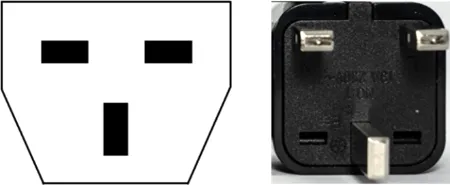
Type G: used in the United Kingdom and countries with strong British influence
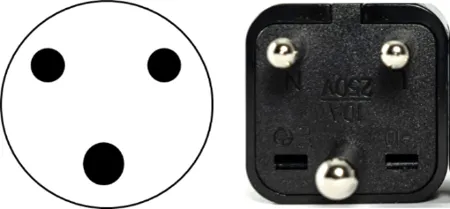
Type D: used in India, Sri Lanka, Nepal, and some African countries
Etiquette in Qatar
Qatar is an Islamic country. And as such, certain behavioral and dress codes must be observed.
Business Opening Times
Businesses that are not engaged in tourism activities typically operate on Islamic week schedules, meaning they are open for business from Sunday to Thursday and close from Friday to Saturday.
Friday afternoon prayers are an important part of Islamic religion and you will see people gather to socialize before and afterwards.
Some small businesses close for prayer five times a day for 10-15 min.
Greeting
Men typically shake hands when they meet or greet each other, but will often not shake hands with women. Qatari women typically do not shake hands.
When you talk to a Qatari person, don’t be surprised if they stand a few feet away from you – respecting other people’s personal space this is showing respect. The same thing is true when you wait in line.
Showing Affection
Public displays of affection between men and women is not unheard of, but frowned upon and gay and lesbian affection is against the law can get you arrested and fined or worse.
Men and women maintaining some distance from each other is considered respectful behavior.
Islamic Dress Code for Tourists
Foreigners are expected to dress appropriately. Women are typically not expected to cover their heads, unless they are visiting a mosque, shrine, or government building. Women should wear a long skirt covering their legs and wear an unrevealing top that covers their shoulders; short sleeves are OK. Bikinis and any kind of nudity are strictly prohibited. Men must not be topless, unless they are on a private beach. Short pants that do not cover the knees are somewhat acceptable for tourists, but frowned upon and not permitted in mosques, shrines, and government buildings. Short sleeves are OK, but should not be sleeveless. As for women, nudity is illegal for men, too.
When visiting a museum, men and women must cover their shoulders and knees.
You must remove your shoes if you get invited to a private home.
Right versus Left
In Qatar, Right is always preferred over Left.
- If you get out of a room or elevator and other people want to enter or if you use the stairs: stay right. This rule does not seem to apply in the Meto.
- The left hand is considered dirty! So, whenever you are greeting someone, accepting, or giving something, only use your right hand. In establishments where food is eaten by hand, never touch the food with your left hand and do not hand plates, cups, or utensils to anyone with your left hand. When eating with your hands, you can use your left hand to cut food with utensils, but you should use your right hand to put the food in your mouth. You will see that Qataris are very skilled eating with the right hand and typically do not use their left hand for eating at all.
The above behaviors are also expected of left-handed Qataris. Foreigners should at least try.
Conflict
People usually go out of their way to avoid conflict. If you show anger or even aggression, people may not deal with you. So, if you get agitated while complaining about something, people may think you are crazy and avoid you.
Illegal items
Illegal drugs, pork, dogs, and non-Muslim religious materials and not allowed in Qatar. Alcohol cannot be imported into Qatar, except by the island resorts. Possessing and consuming alcohol is only permitted in the island resorts.
Gay and lesbian books and pictures are illegal and can get you arrested and fined.
Ramadan
Qatar observe Ramadan and that includes strict fasting from sunrise to sunset.
Ramadan is the ninth month of the Islamic calendar (lunar calendar) in which fasting from dawn to sunset is obligatory for all adult Muslims. Many restaurants will close during the day during Ramadan.
Avoid eating, drinking, or smoking in public during that time.
Here are Ramadan dates for several years:
Start Date |
End Date |
March 10, 2024 |
April 8, 2024 |
February 28, 2025 |
March 30, 2025 |
February 18, 2026 |
March 19, 2026 |
February 7, 2027 |
March 8, 2027 |
January 27, 2028 |
February 25, 2028 |
January 15, 2029 |
February 13, 2029 |
January 5, 2030 |
February 3, 2030 |
Mosques and Shrines
When you enter a mosque, or shrine, you must be appropriately dressed. Shoes, shorts, short skirts, revealing tops, or exposed shoulders are not allowed for men and women. Women must wear at least a head scarf. In some mosques, women will be directed to a dressing room where they will be helped cover up in a traditional Abaya with Shayla.
You will be asked to remove your shoes before you enter a mosque.
Be advised that dirty feet or socks are not acceptable in a mosque.
When you are inside a mosque, don't touch the Qur’an, don’t walk in front of someone who is praying, don’t step over anyone, don't sit or stand on a prayer rug, don’t put anything on top of the Qur’an, don’t cross your legs in front of older people, don't take photos unless you have permission, and remain quiet.
You are typically asked to switch your electronic devices off when people are praying.
Don’t eat or drink in religious sites.
It is always best to arrive at least 30min (better 1h or more) before prayer time for a tour.
Eating
Many people in Qatar eat with their hands at home and in restaurants. As a foreigner, you will almost always be provided with utensils. If you don’t get any, then you can ask for them.
If someone puts food on your plate using their hands, rest assured they have washed their hands before and it is a gesture to guests showing them that they are welcome and important.
As mentioned earlier, if you are eating with your hands, try to use your right hand as much as possible.
Because of all this finger action during a meal, you will usually be provided with bowls to wash your hands after you are done eating. If not, then you need to go to the restroom.
If you are eating in a private home, make sure to taste a little of everything (with your right hand) to not offend your host.
Separate Entrances
In some buildings you will see separate lines for men and women. You must use your gender-specific line.
Photography
Do not take photos of government institutions, especially military areas, refineries, and other sensitive areas. On Qatar’s highways you will see warning signs that tell you when taking photos of industrial areas is illegal.
Also, many Qatari women generally do not like to be photographed – please respect that.
Miscellaneous
- Don’t point fingers at someone – it is considered rude.
- In conversation with a Qatari, or a meeting, do not look at your watch. It is an insult and the other person may walk away.
- Never rest a foot on the knee of the other leg with the foot facing somebody else’s face. This is considered an insult.
- Tipping in Qatar is not required, but as foreigners often tip, it is now sometimes asked for or even expected. In restaurants, cafes, and bars, 10 - 15% is acceptable for good service, and a taxi driver or gas station attendant can be tipped 5 - 10 QAR.
Currency of Qatar
The currency of Qatar is the Qatari riyal (QAR). Since 2001, the Qatari riyal is pegged to the US dollar at a fixed exchange rate of US$1 = QAR 3.64.
You can find the exchange rate here.
Can I use credit cards in Qatar?
The major credit cards VISA and Mastercard are widely accepted in Qatar.
Some smaller vendors, taxis, and restaurants are cash-only. If you don’t have any cash, then make sure to ask if the person you are dealing with accepts credit cards beforehand. We did not get any Qatari riyal (QAR) and we did not need any as everybody we dealt with accepted credit cards, even for purchases below US$1.
Climate of Qatar
Qatar has a hot desert climate with long, extremely hot summers and short, warm winters.
The average high temperatures are typically above 100 F (38 C) between May and September and frequently hit 113 F (45 C). The dewpoint can be above 86 F (30 C) in summer.
Rainfall is scarce, and typically only falls on a few isolated days between October and May.
The climate that you can expect when you visit Qatar is shown here:
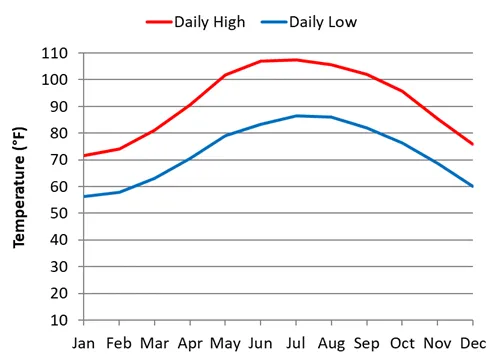
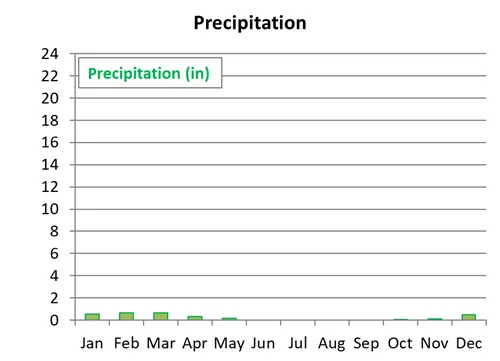
Best time to visit Qatar
The best months to visit Qatar are November through March, as the weather is at its nicest. Summer is extremely hot and outdoor activities can be deadly. Rain falls in small amounts on a few isolated days.
Sandstorms happen when strong winds blow over the desert and pick up sand. They usually happen in the summer, but are not unheard of in April and May. Sandstorms are dangerous - stay indoors. If you are outdoors: do not drive, wear a mask, and protect your eyes.
Never scratch sand, which got in your eyes, out. Only wash it out with water.
Sandstorms are rare occurrences, but it can save your life to stay updated on weather reports, especially when it is windy.
High Season in Qatar
The high season in Qatar runs from November through March, when the temperatures are at their coolest and outdoor activities are in full swing. Beware that it can get cool at night.
The ocean temperature is typically between 67 F (19 C) and 75 F (24 C) from December through March and 82 F (28 C) in November.
Low Season in Qatar
The low season in Qatar runs from June through September. Temperatures soar to dangerous levels, prohibiting any outdoor activities and the humidity is low. The streets are empty during the day as life happens indoors, but Doha comes to life at night.
The ocean temperature is typically between 87 F (31 C) and 93 F (34 C).
Shoulder Seasons in Qatar
Late April and May: This is your last chance to do any outdoor activities. May is already hot, and outdoor activities need to be done with caution.
The ocean temperature is typically around 74 F (23 C) in April and 82 F (28 C) in May.
October: Summer is over and the Qatar baking oven is still hot, but at safer temperatures. Outdoor activities resume.
The ocean temperature is typically around 87 F (31 C).
Getting around in Qatar
Public transportation is very convenient and inexpensive in Doha. Long distance buses service Doha and the rest of the country.
The Doha Metro, and Lusail Tram conveniently use the same Travel Card.
Regular buses require a Karwa Smart Card.
The MetroLink buses and Msheireb Tram are free.
Taxis and Uber are widely available.
While it is nice and inexpensive to use the Metro and buses, we often found it more convenient to use Uber as you get directly to your destination and don’t spend time walking from a Meto or bus station to your destination and you don’t need to wait for a bus either.
We took 7 Uber trips in Doha.
- The charges (including a typical QAR10 tip) were from US$3.78 to US$10.71
- The average was US$6.54 per trip
- The time driven in the Uber was from 8 to 30 min
- The average time driven in the Uber was 15 min per trip
Doha Metro
Opened in 2019, the Doha Metro currently has three lines (red line, green line, gold line) with 37 stations and a total length of 47 miles (76 km).
In 2026, phase 2 will add a blue line.

The metro stations are modern, air conditioned, have wifi (free for 30 min per day per cell phone with login), have beautiful designs, restrooms, and are clean.
Metro trains come every few minutes.
Operating Hours are:
- Sat to Wed: 6am to 11pm
- Thu: 6am to midnight
- Fri: 2pm to midnight
There are two types of Travel Cards that are valid for the Doha Metro, and the Lusail Tram:
- Standard Travel Card
At the time of writing, it costs QR 10, is valid for 5 years, and permits the use of all standard class transportation. A single ride in the metro, and Lusail Tram, no matter how far on a single mode of transportation, costs QAR 2 with a maximum daily cost of QR6, regardless of how many trips you make. The Standard Travel Card can be purchased at every metro station and these retailers: Al Meera, Carrefour, Family Food Centre, Jumbo Electronics, and Lulu Hypermarket. - Gold Club Card
At the time of writing, it costs QR 100, is valid for 5 years, and permits the use of all standard and gold class (similar to 1st Class) sections. A single ride, no matter how far on a single mode of transportation, costs QAR 10 with a daily cap of QAR30, regardless of how many trips you make. The Gold Club Card can only be purchased at the Gold Club offices in the metro stations. Lusail Rail does not have Gold Club seating.

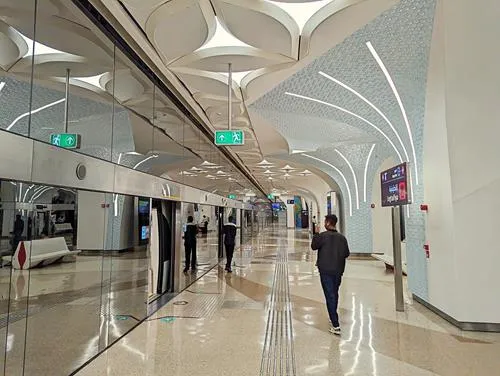
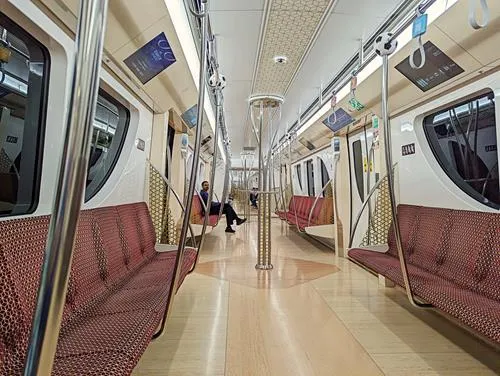
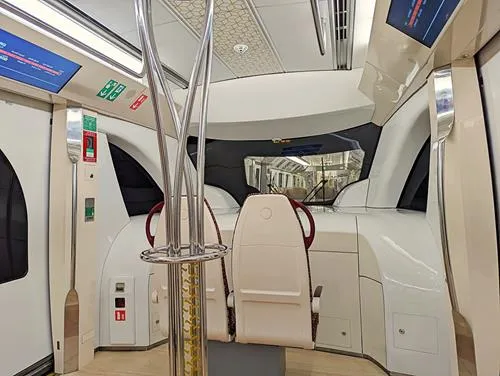
Please remember:
- Family carriages are reserved for families and lone females. Unaccompanied men are not permitted on family carriages
- Gold Club sections can only be used when using the Gold Club Card
- You need to scan your card when you enter the metro through the barriers and when you exit
- You can top up your Standard Travel Card and Gold Club Card at the vending machines in the Metro stations
Lusail Tram
Lusail is a new, planned self-sufficient and environmentally friendly city north of The Pearl in northern Doha. Lusail Tram is a multi-phase light rail project designed to connect Lusail to downtown Doha.
Lusail Tram first opened in 2022 with one line (Orange Line). Three more lines are currently being built and it will eventually have 25 stations on four lines, but at the time of writing, only seven stations on the Orange Line are operational.
In December 2023, the five stations were renamed:
- Energy City South is now Al Wessil
- Lusail Central is now Tarfat-South
- Esplanade is now Marina-North
- Marina Promenade is now Marina-Central
- Marina is now Marina-South
- Legtaifiya and Yacht Club retained their names
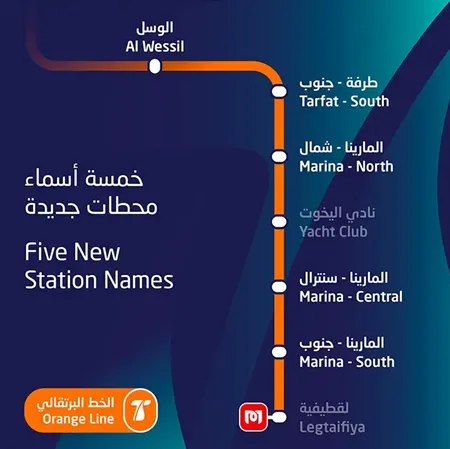
Legtaifiya Station is currently the only station where you can directly transfer between the Doha Metro and Lusail Tram.
Times of operation are:
- Sun to Wed: 5:30am to midnight
- Thu: 5:30am to 1am
- Fri: 2pm to 1am
- Sat: 6am to midnight
Lusail Tram uses the same Standard Travel Card and fare structure as the Doha Metro.
There are, however, no Gold Club seats on Lusail Tram.
Standard Travel Card
At the time of writing, it costs QR 10, is valid for 5 years, and permits the use of all standard class transportation. A single ride in the metro, and Lusail Tram, no matter how far on a single mode of transportation, costs QAR 2 with a maximum daily cost of QR6, regardless of how many trips you make. The Standard Travel Card can be purchased at every metro station and these retailers: Al Meera, Carrefour, Family Food Centre, Jumbo Electronics, and Lulu Hypermarket.
Please remember that you need to scan your card when you enter the train and when you exit.
MetroLink Buses
MetroLink buses are free buses that operate 1.25-mile to 3-mile (2 km to 5km) round trip routes from and to individual metro stations. To use the buses, you will need to scan your Doha Metro Card when you enter the bus. Officially, you will need to scan it again when you leave, but almost nobody does it.
The frequency of the buses depends on the route and time of day and is typically between 6 and 20 min.
At the time of writing, the MetroLink website is undergoing large changes. Timetables have been taken offline and the new tool is not working correctly.
At least, the routes can be looked up and, maybe when you read this, the timetables are back or the route planner is working.
Please check out these two websites:
- https://www.qr.com.qa/metrolink
- https://www.mowasalat.com/mowasalat/public-transportation/routes/
Bus lines starting with the letter M are MetroLink buses, all others are regular buses.
Operating Hours:
- Sunday – Wednesday: 5:30am – 11:59pm
- Thursday: 5:30am – 1:00am
- Friday 2:00pm – 1:00am
- Saturday 6:00am – 11:59pm
Regular Buses
Mowasalat operates 50 bus routes daily. Depending on the route, operations start as early as 4am and the last buses depart as late as 11pm. Most routes operate from the Al Ghanim Bus Station near the Gold Souq in central Doha.
At the time of writing, the Mowasalat website is undergoing large changes. Timetables have been taken offline and the new tool is not working correctly.
At least, the routes can be looked up and, maybe when you read this, the timetables are back or the route planner is working.
You will need to buy a Karwa Smart Card to use the buses. There are three types of Smart Cards that you can buy:
- Classic Card
Cost: QAR 30, this card is rechargeable in QAR 10 increments - Limited Card
Cost: QAR 10, it is good for two journeys within 24-hrs of purchase - Unlimited Card
Cost: QAR 20, it is good for unlimited journeys within 24-hrs of purchase
Karwa Smart Cards can be purchased at Hamad International Airport, Doha Bus Station, The Pearl Qatar and Qatar Mall, and many merchants.
Fares start from QAR 2.50 for short trips. The maximum single fare is QAR 9 for long distance trips to Al Shamal or Abu Samra on the border to Saudi Arabia.
Please remember that:
- the front of the buses are reserved for women and children
- you need to scan your card when you enter the bus and when you exit
Msheireb Tram
The Msheireb Tram operates on a single 1.25 mile (2 km), closed-loop track in downtown Doha (Msheireb). It includes nine stops, is free of charge, air conditioned, has free wifi, and is equipped with heat-shielding glass.
Its operating times are:
- Sat - Thu: 10am - 10pm
- Fri: 2pm - 10pm
The trams come every 6min from 5.30pm - 9.30pm. Outside this time, every 15min.
A full round takes about 18 min.
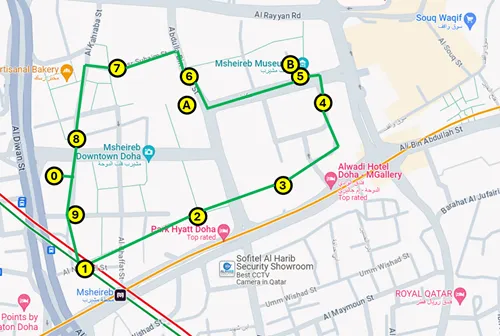
Stations:
0) Tram Depot
1) Sahat Al Nakheel Station
2) Wadi Msheireb Station
3) Galleria Station
4) Msheireb Prayer Ground Station
5) Heritage Quarter Station
6) Al Baraha Station
7) Sahat Al-Masjid Station
8) Al Kahraba Street Station
9) Al Mariah Street Station
Education City Tram
The Education City Tram (EC Tram) is a free tram which operates within Education City, northeast of Doha.
It has 24 stations on three lines (yellow line, blue line, green line). Each of the 19 trams is air conditioned and has 64 seats.
Operation hours are:
- Sun - Thu: 6am to 10pm
- Fri - Sat: 6am to 4pm
The EC Tram yellow line connects to the green line of the Doha Metro at the Al Shaqab Metro station.
The Qatar National Library and Education City Metro stops are within easy walking distance of the EC Tram.
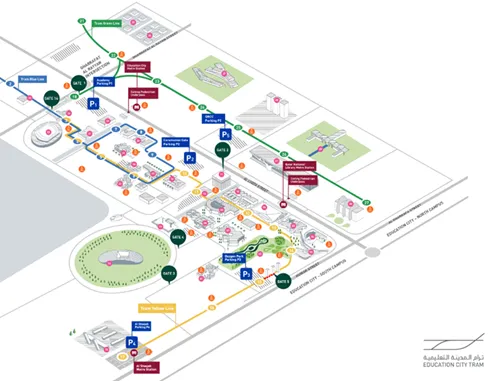
Taxis in Qatar
Karwa operates turquoise-colored taxis with different colored roofs. The most common are the ones with the silver roof. You will also find turquoise taxis with yellow, maroon, blue and dark grey roofs – those are franchises under the same parent company.
You can hail Karwa taxis in the streets, or use the Mowasalat app, or call 800-8294 (800-TAXI), or go to the taxi stands e.g. near shopping malls, hotels, Doha airport, etc.
Karwa taxis accept cash, credit card, and google pay and apple pay.
If you use the Karwa app to order a Karwa taxi from or to a metro station, then you can save money by using the MetroExpress option in the app.
Karwa taxis are metered and the rates are set by the government. Please be advised that the base fare from Doha airport is QAR 25, while it is QAR 7 elsewhere in Doha.
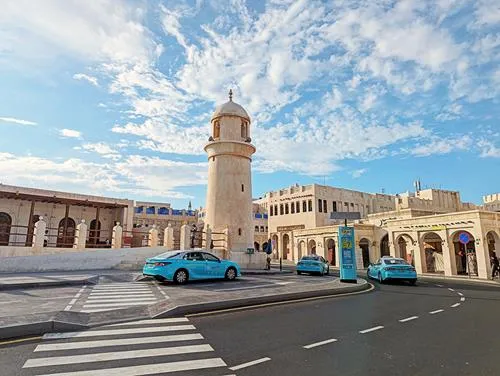
Uber in Qatar
Your uber app will function the same way in Qatar as it does at home. Uber is a convenient and popular way to travel in Doha. You pay with your credit card and know in advance how much you will pay.
If you have just arrived at the Doha airport and have no data plan, use the free wifi inside the terminal to order your uber. Once your ride is confirmed and your driver is close to the terminal, leave the terminal, which will end your wifi connection, and meet your uber.
Careem (not in Qatar anymore)
Careem seized their operations in Qatar in 2023, so disregard that some websites claim that they still operate in Doha.
Water Taxis
Under the Qatar 2050 Transportation Master Plan, Qatar plans to introduce water taxis. An evaluation is currently ongoing, and it appears likely that there will be water taxi services between beaches from Lusail in the north and Doha’s Corniche in the south.
As of now, the only thing operating is a Water Shuttle service within The Pearl between Porto Arabia and the Qanat Quartier.
Operating hours are 9am – 11pm. Call to schedule a pick-up: +974 4409 5279 or +974 6674 1577
The price at the time of writing is:
- Within Porto Arabia or Qanat Quartier: QAR 40 per person
- From Porto Arabia to Qanat Quartier or reverse: QAR 80 per person
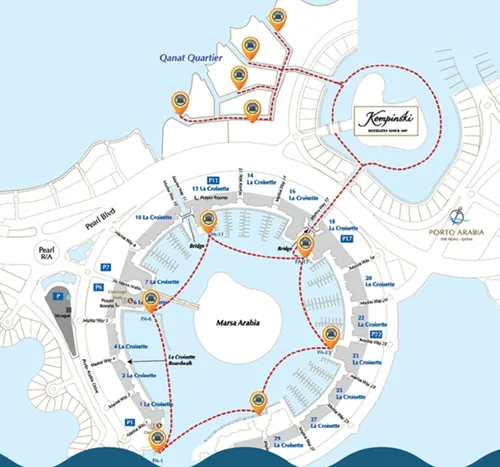
Rental Cars in Qatar
Driving a rental car in Qatar is straightforward - you can book rental cars in Doha here. The roads that you will take are all paved, fairly wide, and in excellent shape. Traffic rules are also straightforward and Google maps is reliable in Qatar.
Here are some road signs that you should know:

There are lots of speed limit signs and you will usually have a speed limit sign shortly before you come to a radar trap. Typical speed limits are:
- City Roads 60-100 km/h
- Highways 100-120 km/h
The warning I have for you is: Obey the speed limit at all times! Speed cameras are everywhere and they are frequently placed every thousand feet (few hundred meters) or so and you can even find them on rural highways.
Because of all the radar traps and the hefty fines, you will find that most people drive below the posted speed limit, and you should absolutely do that too!
Internet access in Qatar
In Qatar, 99% of the population have internet access and internet speed is the fourth highest in the word after UAE, Norway, and South Korea.
Mobile network providers in Qatar are Ooredoo Qatar (state owned) and Vodafone Qatar. Both offer 5G networks.
Many public places in Qatar offer free wifi, e.g. Doha airport, restaurants & cafes, some parks, shopping malls, and government buildings. In most cases you will need to authenticate yourself, and you will be asked if you want to access the free or a paid wifi plan. Sometimes, the free wifi plan comes with a data limit, or time limit.
Access to social media is available, but some websites that are deemed to go against the cultural and moral values of Qatar are blocked.
The internet extension for Qatar is: .qa
Calling Qatar
The country code for telephone calls to Qatar is: +974
Language spoken in Qatar
The only official language in Qatar is Arabic.
English has become the second most spoken language in Qatar. It is taught in school and is the most used language in business – after all, there are 2.3 mio expats and only 0.3 mio Qataris in the country.
English descriptions can typically be found in museums and in larger stores.
Highlights of the history of Qatar
- 50,000 years ago: stone age people first settle in what is now Qatar
- 6th millennium BC: Qatar is part of the Ubaid civilization (originates in Mesopotamia)
- 4th century BC: Qatar is under the influence of the Seleucid Empire
- 224 AD: Qatar is under control of the Sasanian Empire, which introduces Christianity to some of the population
- 628: Islamic prophet Muhammad sends an envoy to the governor of the Persian Sasanian Empire and requests that he and his subjects accept Islam. The governor converts to Islam and so do most of the Arab tribes in the region
- 651: Almost the entire Sasanian Empire, including Qatar, is conquered Rashidun Caliphate
- 661 – 750: During the Umayyad Caliphate, Qatar is famous for horse and camel breeding
- 8th century: During the Abbasid Caliphate, Qatar is an important center for pearl harvesting and trading. It will last well into the 20th century
- 9th and 10th century: Qatar is invaded and ruled by the Qarmatians, a radical Shia sect
- 1253: The Usfurids take control of Qatar
- 1320: The kingdom of Ormus takes control of Qatar
- 14th century: The Jarwanid dynasty takes control of Qatar
- 15th century: The Jabrids (Al Juboor) take control of Qatar
- Mid-16th century: The Portuguese invade the Gulf and build a fort in Ruwayda in northern Qatar, to protect their share of the pearl trade
- 1546: The Ottomans confront the Portuguese and extend control to the Qatar peninsula
- 1563: The fortress of the "City of Qatar" is first mentioned on a Portuguese map
- 1627 and 1628: The Portuguese fleet raids the Qatari coast multiple times and force the Qataris to sell their pearls through Ottoman allies, instead of Bahrain
- 1670: The Ottomans, who have only negligible military presence in Qatar, are expelled by the Bani Khalid tribe
- 1766: Members of the Al Khalifa family migrate from Kuwait to Qatar
- 1775: Basra, the hub of the pearling industry in the Arabian Gulf is besieged, and then struck by the plague. Many important merchant families move to Al Zubarah (Qatar), and make it one of the most important and prosperous cities in the Gulf
- 1776: Mohammed bin Thani is born
- 1783: Bahrain is jealous of Al Zubarah and attack it. Qatar prevails in the battle of Nassour
- 1797: After unsuccessful attacks on Al Zubarah, the first Saudi State takes control of the town
- 1802: The first Saudi State takes control Qatar and merchants move out of Al Zubarah
- 1811: Al Zubarah is destroyed in a battle between Muscat and first Saudi State
- 1818: The first Saudi State is defeated by the Ottomans, Egyptians, Al Khalifa, and the Omanis and Al Khalifa is now back power
- 1821: Al Bidda is now the largest and most important town in Qatar. The East India Company blames the inhabitants of Al Bidda of piracy and breach of a treaty they had not agreed to, bombards the town, effectively razing it, and forcing 300 - 400 natives to flee and catalyzing the founding of Doha nearby
- 1823: Britain completes the first naval survey of Qatar’s coast
- 1839: Mohammed bin Thani becomes Sheikh of his tribe in Fuwairat
- 1848: Sheikh Mohammed bin Thani becomes the leader of Doha
- 1851: Sheikh Mohammed bin Thani becomes the ruler of Qatar
- 1867: In the maritime Qatari–Bahraini War, Al Khalifa, who rule Qatar from Bahrain, and Abu Dhabi destroy rebel strongholds in Doha, Al Wakrah, and loot both cities
- 1868: Because the Qatari–Bahraini War violates the 1861 Perpetual Truce of Peace and Friendship agreement between Britain and Bahrain, the British intervene and impose a peace treaty that recognizes the Qatar and Bahrain as separate states and Mohammed bin Thani (Al Thani family) as the leader of Qatar
- 1871: Qatar submits to Ottoman rule under their military and political pressure
- 1892: After the Ottomans tried to undermine Al Thani, he and his allies stop paying taxes
- 1893: The Ottoman Empire tries to the collect taxes that Al Thani stopped paying, and imprisons 16 Qatari tribal leaders, but is forced to surrender to Al Thani’s troops in the Battle of Al Wajbah. As a result, Qatar gains partial independence within the Ottoman Empire.
- 1913: At a time when education in Qatar is limited to informal Qur'an schools, Sheikh Abdullah bin Jassim Al Thani establishes Al Athariyyah School where Arabic language and Islamic law is taught
- 1913: Britain and the Ottoman Empire agree that the Ottomans retreat from Qatar and abandon their garrison in Doha
- 1915: Because the Ottoman garrison in Doha is still occupied, the British send gunboats in the harbor and Al Thani negotiates an overnight Ottoman retreat from the garrison
- 1917: Qatar becomes a British protectorate and its borders are defined. Britain now controls Qatar’s foreign affairs and defense, in exchange for British protection and support. Al Thani oversees all internal affairs
- 1929: Black Tuesday in the USA triggers a worldwide economic depression, and demand for pearls drops drastically, badly affecting the Gulf
- 1930: The increased popularity of the cultured pearl allows production of pearls in large quantities at low cost, collapsing Qatar’s dominant source of income
- 1935: Qatar grants a 75-year oil concession to the Iraq Petroleum Company
- 1939: Oil is discovered, but World War II delays its exploitation
- 1949: Oil exports begin and quickly become the country's main source of revenue as the pearl trade is declining
- 1961: Qatar joins OPEC
- 1968: Britain announces its intent to withdraw from the Persian Gulf by 1971. Qatar, Bahrain and the seven Trucial States (which later become the United Arab Emirates) start negotiations to form a federation. The negotiations fall apart and Qatar prepares to become an independent country
- 1971: Qatar declares its independence from Britain and Sheikh Ahmad ibn Ali Al Thani becomes the first emir of independent Qatar
- 1977: Qatar nationalizes its oil industry and ends foreign concessions. Qatar invests in natural gas, and petrochemicals
- 1991: Qatar participates in the Gulf War on the side of the Allies
- 1995: Sheikh Hamad ibn Khalifah Al Thani deposes his father Sheikh Khalifah ibn Hamad Al Thani, who is traveling abroad, and starts a series of political and social reforms
- 1996: Qatar launches satellite television network Al Jazeera. Al Jazeera will become one of the most influential and controversial media outlets in the Arab world
- 1999: Qatar allows women to vote in municipal elections, and grants women the right to drive, travel, and work without male permission, and appoints women to high-ranking positions in the government and the judiciary
- 2003: Qatar serves as the United States Central Command headquarters and one of the main launching sites of the invasion of Iraq
- 2005: Qataris approve the new constitution by a popular referendum. The constitution establishes a constitutional monarchy, with the emir as the head of state and chief executive. The emir appoints the prime minister as the head of government and the cabinet. The legislature consists of 30 elected Advisory Council members and 15 Council of Ministers, who are appointees from the emir.
- 2006: Qatar and Saudi Arabia resolve their long-standing border dispute
- 2008: The first Roman Catholic church in Qatar is inaugurated
- 2000 – 2010: Qatar’s GDP growth is the fastest in the world
- 2022: Qatar becomes the first Arab and Muslim-majority country to host the FIFA World Cup
Where to Stay in Doha
Doha is one of the fastest-growing hotel and hospitality markets in the world and new hotels are constantly being built. Visitors can choose from a wide selection of properties from budget hotels to 5-star luxury hotels.
Here is what is available during your stay:
Hampton By Hilton Doha Old Town (book)
This hotel combines Hampton Inn quality with excellent location and comparably low room rates and that makes it a clear winner in our minds.
It is located in walking distance to several restaurants, the National Museum of Qatar, MIA Park and the National Museum Metro Station on the Golden Metro Line. Souq Waqif is one Metro stop away and Msheireb two - both are also on the Golden Metro Line. Whenever we called an Uber, our wait was somewhere between 1 and 3min until it arrived.
The hotel itself has spacious good quality rooms which show very little sign of wear. The air conditioner was quiet and efficient. Shampoo, conditioner and body wash were provided in multi-use dispensers.
Breakfast is served buffet-style and the selection is huge, including typical continental American breakfast dishes, Arabian breakfast dishes, different types of bread, sausages (no pork) and cheese, and various types of fruits and yogurts. Coffee machines provide different types of coffee, but milk, hot water and various teas and juices are available too.
The hotel also has a fitness center.
We found the staff to be very friendly and helpful.


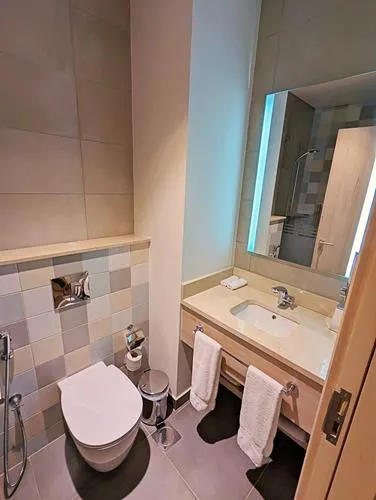
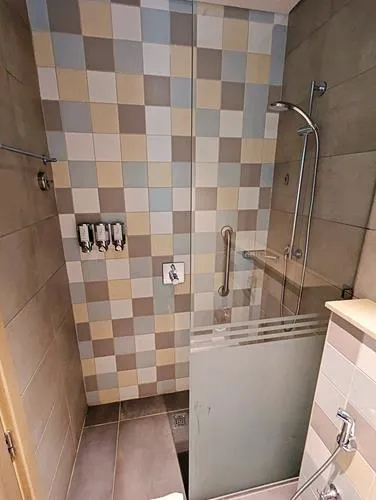
Eight Wonderful Days in Qatar
Qatar can easily be explored on an 8-day itinerary. You should reserve four full days for Doha and two or three days to see the rest of the country.
Below is an itinerary that we propose for first-time visitors of Qatar.
If you have ever done dune bashing and camel rides, then you can skip the tour on Day 6 and substitute it with a day trip to northern Qatar that includes kayaking the Al Thakira Mangroves and visiting the Al-Zubarah Fort.
Of course, you can always add that to the itinerary below and visit Qatar for 8 days.
Day 1: Arriving in Doha
Today you will arrive in Doha. Customs and immigration at the airport are efficient and usually quick.
Once you get your luggage and exit the secure area, you need to decide if you want to get local currency or not. We never got any local currency, but if you want to get some, then you can either exchange some money or get some from an ATM machine.
Afterwards, you can either walk out of the terminal and get a taxi, or follow the signs to the Metro Station – this is about a 10min walk.
In late 2023, Uber was forced by the government to stop pick-up service at the airport – airport drop-offs are not affected. This ban is still in effect at the time of writing.
You can try your Uber app to see if the ban has been lifted when you are there. Just be advised that the free airport wifi only works inside the terminal. Once you get close to the doors or exit the building, you will likely not have any wifi signal. So, order your uber from inside the terminal.
Once you arrive at the Metro Station, buy your Metro Card(s) and start enjoying the Metro experience.
If you plan on using the free Metro wifi, make sure to do the initial sign up while you are still waiting for your train in the station – do not try it after you get into the carriages as this can be a frustrating experience with lots of dropped and timed-out connections during the sign-up process.
Depending on when you arrive, you can visit some of the sights from the Day 2 itinerary or just relax in your hotel.
Should you stay in the Hampton By Hilton Doha Old Town, then we recommend to check out nearby Al Mathaf Park
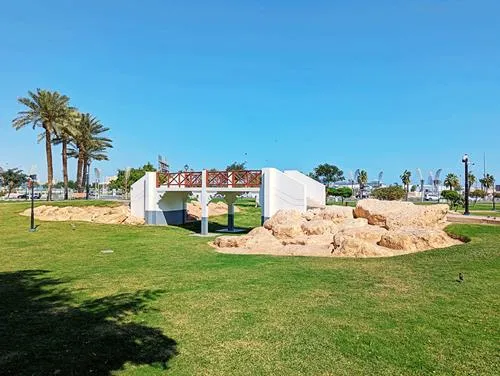
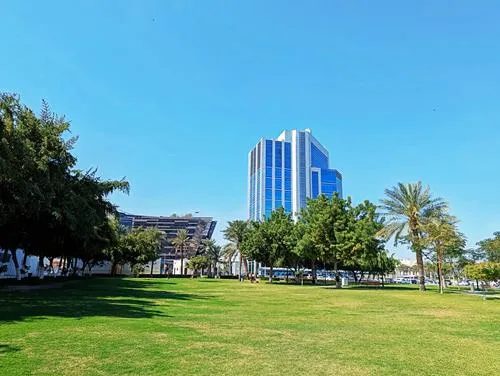
and the Museum Restaurant. We loved the food and made this our most-visited restaurant in Doha.
Where do you want to go now?
Author: Rudy at Backpack and Snorkel
Bio: Owner of Backpack and Snorkel Travel Guides. We create in-depth guides to help you plan unforgettable vacations around the world.
Other popular Purple Travel Guides you may be interested in:
Like this Backpack and Snorkel Purple Travel Guide? Pin these for later:







